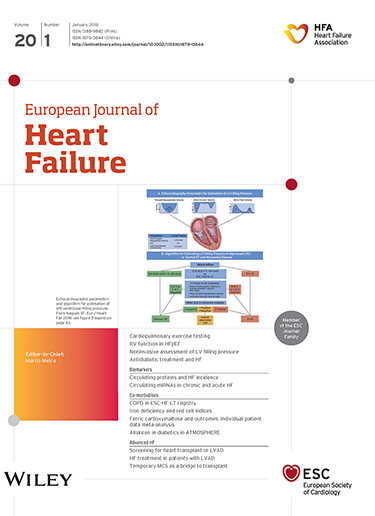An individual treatment effect approach to predict response to mineralocorticoid receptor antagonists in patients with heart failure and reduced ejection fraction.
IF 10.8
1区 医学
Q1 CARDIAC & CARDIOVASCULAR SYSTEMS
引用次数: 0
Abstract
AIMS Mineralocorticoid receptor antagonists (MRAs) are often underused in patients with heart failure (HF) and reduced ejection fraction (HFrEF). Individual treatment effect (ITE) may assist physicians in making timely decisions about which patients are the best suited for personalized therapy. We aimed at developing and validating a model to estimate ITE of MRAs in patients with HFrEF. METHODS AND RESULTS RALES and EMPHASIS-HF trials were the derivation trials used to estimate ITE of MRAs versus placebo on cardiovascular death or HF hospitalization in HFrEF over a 2-year period using counterfactual random forest method. ITE prediction models were built using linear regression and applied to the EPHESUS trial in patients with left ventricular systolic dysfunction and/or HF after myocardial infarction. In the RALES and EMPHASIS-HF trials (n = 3887), age, body weight, blood pressure, heart rate, hypertension and diabetes prevalence, stroke history, left ventricular ejection fraction, renal function, and serum sodium and potassium concentrations were identified to determine ITE scores (adjusted R2 = 0.25). As ITE scores increased, hazard ratio for treatment effect decreased from 0.82 (95% confidence interval [CI] 0.67-1.02) at ITE score 5 to 0.47 (95% CI 0.35-0.63) at ITE score 20 (p for interaction = 0.014). In the EPHESUS trial (n = 6472), a similar pattern was observed, with greater treatment effects in patients with higher ITE scores (p for interaction = 0.007). CONCLUSIONS In HFrEF across various clinical settings, our simple ITE model predicted individual responses to MRA therapy. Although treatment effects may be attenuated at lower ITE scores, point estimates with wide CIs still generally favour benefit, suggesting that these patients still benefit.预测心力衰竭和射血分数降低患者对矿皮质激素受体拮抗剂反应的个体治疗效果方法。
矿皮质激素受体拮抗剂(MRAs)通常在心力衰竭(HF)和射血分数降低(HFrEF)患者中使用不足。个体治疗效果(ITE)可以帮助医生及时决定哪些患者最适合进行个性化治疗。我们的目的是开发和验证一个模型来估计HFrEF患者的mra的ITE。方法和结果rales和强调-HF试验是衍生试验,用于使用反事实随机森林方法估计MRAs与安慰剂在2年期间HFrEF中心血管死亡或HF住院的风险。使用线性回归建立ITE预测模型,并将其应用于EPHESUS试验,用于心肌梗死后左室收缩功能障碍和/或HF患者。在RALES和强调- hf试验(n = 3887)中,确定年龄、体重、血压、心率、高血压和糖尿病患病率、卒中史、左心室射血分数、肾功能和血清钠和钾浓度来确定ITE评分(调整R2 = 0.25)。随着ITE评分的增加,治疗效果的风险比从5分时的0.82(95%可信区间[CI] 0.67-1.02)下降到20分时的0.47 (95% CI 0.35-0.63)(相互作用p = 0.014)。在EPHESUS试验(n = 6472)中,观察到类似的模式,ITE评分越高的患者治疗效果越好(相互作用p = 0.007)。结论:在不同临床环境下的HFrEF中,我们的简单ITE模型预测了个体对MRA治疗的反应。尽管较低的ITE评分可能会减弱治疗效果,但广泛ci的积分估计仍然普遍有利于获益,这表明这些患者仍然受益。
本文章由计算机程序翻译,如有差异,请以英文原文为准。
求助全文
约1分钟内获得全文
求助全文
来源期刊

European Journal of Heart Failure
医学-心血管系统
CiteScore
27.30
自引率
11.50%
发文量
365
审稿时长
1 months
期刊介绍:
European Journal of Heart Failure is an international journal dedicated to advancing knowledge in the field of heart failure management. The journal publishes reviews and editorials aimed at improving understanding, prevention, investigation, and treatment of heart failure. It covers various disciplines such as molecular and cellular biology, pathology, physiology, electrophysiology, pharmacology, clinical sciences, social sciences, and population sciences. The journal welcomes submissions of manuscripts on basic, clinical, and population sciences, as well as original contributions on nursing, care of the elderly, primary care, health economics, and other related specialist fields. It is published monthly and has a readership that includes cardiologists, emergency room physicians, intensivists, internists, general physicians, cardiac nurses, diabetologists, epidemiologists, basic scientists focusing on cardiovascular research, and those working in rehabilitation. The journal is abstracted and indexed in various databases such as Academic Search, Embase, MEDLINE/PubMed, and Science Citation Index.
 求助内容:
求助内容: 应助结果提醒方式:
应助结果提醒方式:


